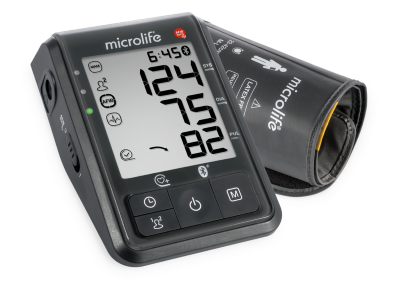Read the article
For a printable version to share with your patients, please download the PDF.

WHAT DOES BLOOD PRESSURE MEASURE?
Blood pressure measures the force with which blood pushes against the arteries. Arteries carry blood from the heart to the rest of the body. When your blood pressure is high, it means that your arteries are under increased stress due to a higher pressure pushing against the arterial walls.
HOW IS BLOOD PRESSURE MEASURED?
Measuring your blood pressure is a painless process. A cuff is wrapped around your upper arm and is inflated. The purpose of inflating the cuff is to momentarily restrict blood flow through the upper arm. The cuff is then slowly deflated to allow for normal blood flow through the arm to return. Blood pressure is measured with 2 numbers: the systolic pressure (top number) and the diastolic pressure (bottom number). A normal systolic pressure is below 120 and normal diastolic pressure is below 80.
HOW DO I KNOW IF MY BLOOD PRESSURE IS HIGH?
Many patients with a high blood pressure (hypertension) have no symptoms, which has led to hypertension being commonly referred to as a “silent killer.” This is why it is important that you get your pressure checked regularly by a healthcare professional or by using a blood pressure machine at home. If symptoms are present, they can include headaches, chest pain, difficulty breathing, nausea, vomiting, and anxiety.
WHEN SHOULD I GET SCREENED?
If you have not checked your blood pressure at least once during the last year, consider visiting a clinical office or your pharmacy to get a reading. Your healthcare provider may also recommend purchasing an at-home blood pressure machine, which can be found at your local drug store or through your insurance company.
HOW CAN I CHECK MY BLOOD PRESSURE BY MYSELF?
- Rest for a few minutes before sitting straight on a supportive surface with your legs uncrossed and flat on the ground
- Wrap your cuff on your upper arm just above your elbow on bare skin with your arm outstretched in front of you with your palm facing upwards
- Try to measure your blood pressure at the same time every day and take multiple readings a few minutes apart
- Note the date and your readings in a journal that you can bring to your next clinical appointment
WHAT CAN I DO TO LOWER A HIGH BLOOD PRESSURE?
Some of the best ways you can lower an elevated blood pressure and reduce your long-term health risks are to exercise regularly, eat a healthy diet that is low in sodium, limit alcohol consumption, stop smoking, maintain a healthy sleep schedule, and find healthy ways to cope with stress. In addition to these lifestyle modifications, some patients may require medications to keep their blood pressure under control.
SOURCES:
Centers for Disease Control and Prevention. About high blood pressure. https://www.cdc.gov/high-blood-pressure/about/?CDC_AAref_Val=https://www.cdc.gov/ bloodpressure/about.htm.
Mayo Clinic. Blood pressure tests. https://www.mayoclinic.org/tests-procedures/ blood-pressure-test/about/pac-20393098.
World Health Organization. Key facts about hypertension. https://www.who.int/news-room/fact-sheets/detail/hypertension.
Informedhealth.org. What is blood pressure and how is it measured?” https://www.ncbi.nlm.nih.gov/books/NBK279251.
American Heart Association. Monitoring your blood pressure at home. https://www.heart.org/en/health-topics/high-blood-pressure/understanding-blood-pres- sure-readings/monitoring-your-blood-pressure-at-home.